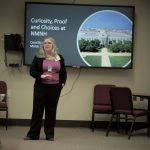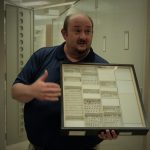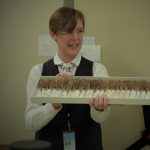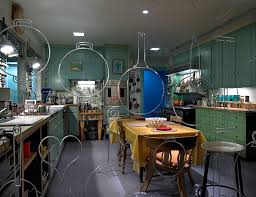by Professor Erin Aust After weeks of anxious uncertainty, the Smithsonian National Museum of Natural…
On a surprisingly beautiful March afternoon, the 2023 Smithsonian Faculty Fellowship cohort traveled to the National Museum of Natural History (NMNH) for the Opening Panel that traditionally begins our Fellowship seminars. After five weeks of Zoom meetings, many were meeting in person for the first time, and for the Coordinators of the program, it was hard to believe that this was to be our first in person event in three years. Needless to say, enthusiasm and anticipation were high.
The afternoon began with lunch and introductions as the group was welcomed by Philippa Rappaport, Smithsonian Office of Educational Technology and Carol Butler, Associate Director of Collections, NMNH.
The theme for this year’s Fellowship, The Evolving Role of Museums: Preserving the Past, Portraying the Present, and Shaping the Future, was the focus of the afternoon.

Our first presenter, Dr. Alison Cawood, is the Citizen Science Coordinator at the Smithsonian Environmental Research Center (SERC). The mission of SERC, in part is to provide science-based knowledge to address the environmental challenges of the 21st century. SERC is a recognized leader on coastal ecosystem research that can be used in real-world decision making. The work they do is always guided by thinking about how to create policies that combine best business practices while also working to sustain the planet.
Her presentation demonstrated the multifaceted citizen science programs and opportunities through which people of all ages can become “citizen scientists” and participate in scientific research. This work provides valuable data and information to the professional scientific community and facilitates research not otherwise possible.
She shared a variety of ongoing research projects at SERC that rely in part, on a network of citizen scientists such as the Global Change Research Network (GCREW) where volunteer s are making important contributions to our understanding of the impacts of climate change on wetlands and forests. She shared a number of citizen science programs that faculty and students could become involved in such as Zooniverse (https://www.zooniverse.org/), iNaturalist (https://www.inaturalist.org/), SciStarter (https://scistarter.org/) and Citizen Science (https://citizenscience.org/). This presentation reminded all that museums are more than just objects on display, but also encompass ongoing research that has current day real-world applicability.

Our second presenter was Carol Butler who spoke about “Curiosity, Proof and Choices at NMNM.” Fellows heard a short history of natural history museums from the early days of Kunsthammers, or Cabinets of Curiosities. Often located in private homes, these began as ways to showcase personal possessions, demonstrate power, prestige and wealth and, provide entertainment. Eventually, there was a move to documentation of observations and preservation of objects, central to what we see in today’s museums. The NMNH continues to document and preserve, while also being future oriented, research and curiosity driven, and strives to be responsive to the communities they serve. She stressed the importance of record keeping, demonstrating a number of ways records help fulfill the NMNH mission and further the evolving role museums have in preserving the past, portraying the present and shaping the future.

To highlight these presentations, two terrific behind-the-scenes tours rounded out the afternoon. First, the group had the opportunity to learn about the Insect, Arachnid and Myriapod Collection- or insects and bugs. Dr. Floyd Shockley, Collections Manager for the NMNH’s Department of Entomology, introduced us to a collection which contains more than 35 million specimens and is one of the largest, most comprehensive entomological collections in the world. As impressive as this is, Dr. Shockley also stated that humans share the planet with between 10-30 million species, accounting for 80% of known life on Earth, yet less than 10% of these species are known to science. Clearly there is much more to be learned!
Fellows learned about the ways in which specimens are collected and persevered, along with the many ways researchers have used and are continuing to use the collection. The group learned of a number of medical and agricultural benefits that have come from this research. A number of specimens were on view, adding to the presentation.

Ingrid Rochon, Museum Technician in the NMNH Division of Mammals provided a look at some of their collection which numbers about 590,000 items. As with the Insect, Arachnid and Myriapod collection, the work of this Division involves preserving, conserving and documenting all items in the collection as well as being actively engaged in research. Fellows were able to examine pangolin scales, learn about how a variety of mammals have been used in research beneficial to humans and, it is doubtful anyone will forget the tour of the bat specimen room!
Our afternoon ended in the Q?rius Lab, NMNH’s interactive learning space that allows kids through teens (and their parents!) to explore more than 6,000 objects, and engage in hands on activities and experiments. As we emerge from the Covid pandemic, plans are well underway to reopen this space with a full slate of programming.
The afternoon was energizing, and the group is looking forward to the next seminar.





This Post Has 0 Comments